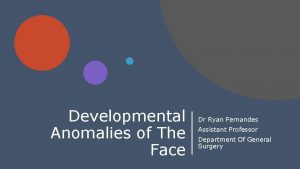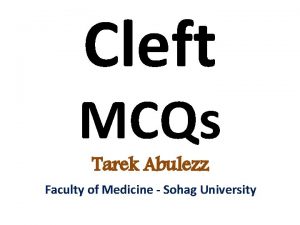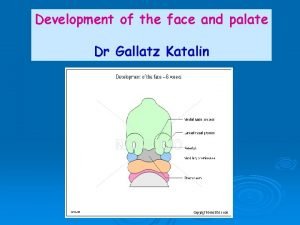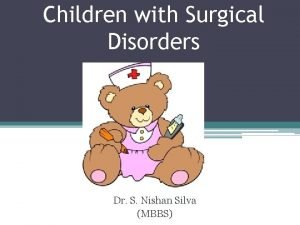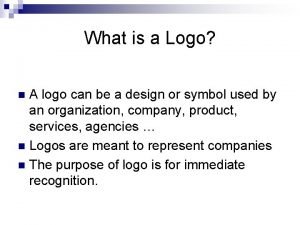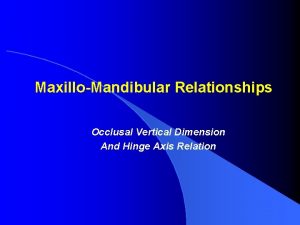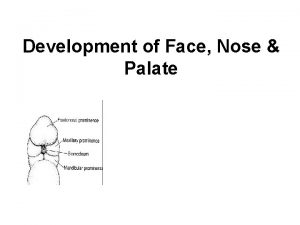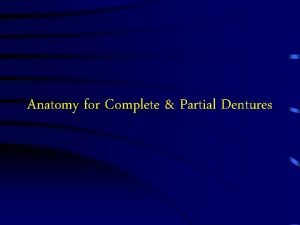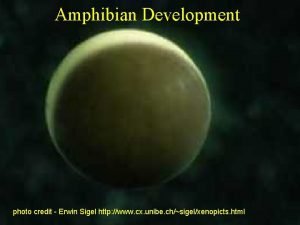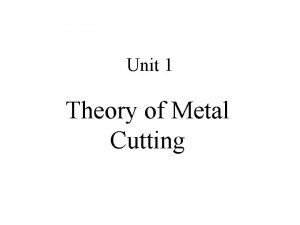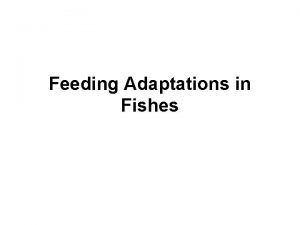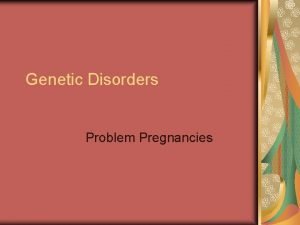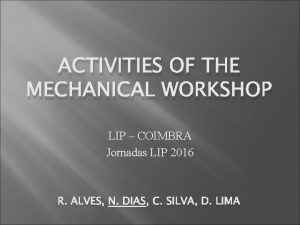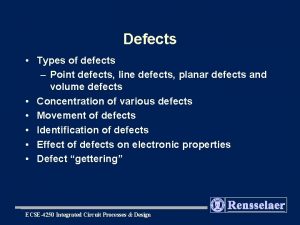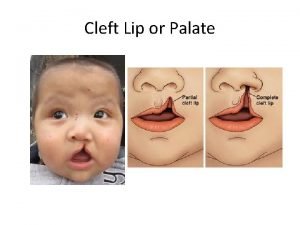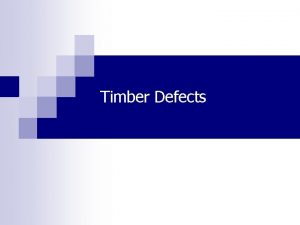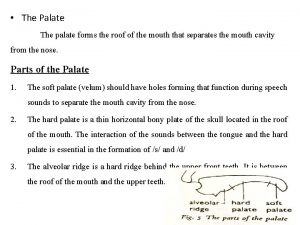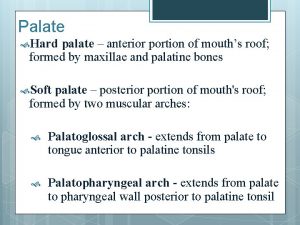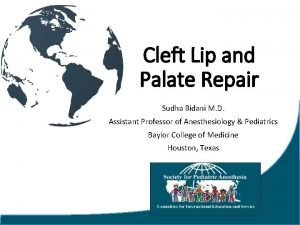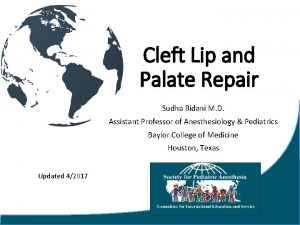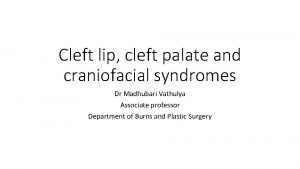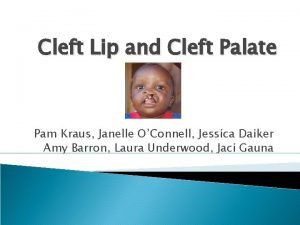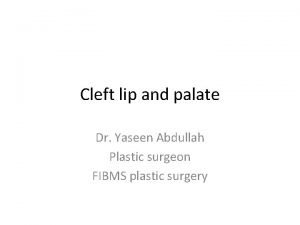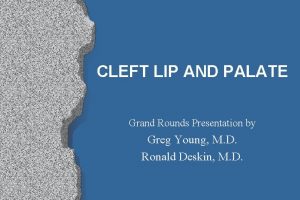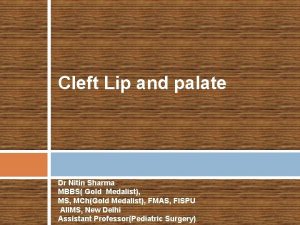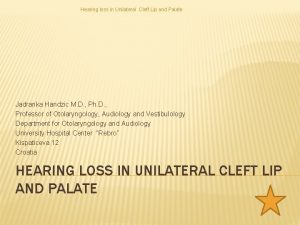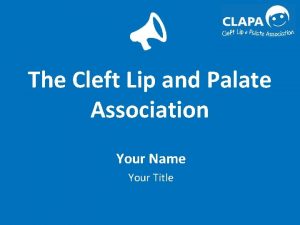Developmental Defects of the Lip and Palate OROFACIAL



































- Slides: 35

Developmental Defects of the Lip and Palate

OROFACIAL CLEFTS • 1 -CLEFT LIP AND PALATE Cleft lip: • It is a developmental anomaly characterized by a wedge-shaped defect in the lip, which results from failure of two parts of the lip to fuse together at the time of development. • This defect is more commonly seen in relation to the upper lip.

CLEFT PALATE • It is a developmental defect of palate characterized by lack of complete fusion of two lateral halves of the palate resulting in a cleft. • Cleft in the palate leads to communication between oral and the nasal cavity.

ETIOLOGY: �Heredity. �Environmental factors such as: �Insufficent nutrition to pregnant women �Defective vascular supply �Size of the tongue prevent union of affected parts �Infections , certain alcohol , drugs and toxins

Classification • cleft lip • Unilateral (usually on the left side), with or without an anterior alveolar ridge cleft • Bilateral, with or without alveolar ridge clefts, complete or incomplete Palatal clefts • Bifid uvula • Soft palate only • Both hard and soft palate

Combined lip and palatal defects • Unilateral, complete or incomplete • Cleft palate with bilateral cleft lip, complete or incomplete

Oblique Facial Cleft • Extends from the upper lip to the eye. It is nearly always associated with CP. • Some of these clefts may represent failure of fusion of the lateral nasal process with the maxillary process.

Lateral Facial cleft • It is caused by lack of fusion of the maxillary and mandibular processes. • This cleft may be unilateral or bilateral. • Extending from the commissure toward the ear, resulting in macrostomia. • May occur as an isolated defect, but more often it is associated with other disorders.




Congenital lip pits


Commissural lip pits

Developmental Defects of the Jaw Bones

AGNATHIA • Absence of one of the jaws • Rare condition • Mostly occurs in mandible

MACROGNATHIA • Abnormally large jaw • Due to : - Fibrous dysplasia - Bone tumors - Odontogenic cysts - Associated with acromegaly or pagets disease

MICROGNATHIA • Abnormally small size of one of the jaws • May be associated with Pierre Robin syndrome

coronoid Hyperplasia • A rare developmental anomaly that may result in limitation of mandibular movement. • The cause of coronoid hyperplasia is unknown. • Because most cases have been seen in pubertal males, an endocrine influence has been suggested. • Coronoid hyperplasia may be unilateral or bilateral, • Unilateral enlargement of the coronoid process also can result from a true tumor, such as an osteoma or osteochondroma, .

Condylar Hyperplasia • Excessive growth of one condyle • Unknown cause • Endocrine disturbances and trauma may be etiological factors

Hemifacial Hypertrophy • Unilateral enlargement of face as a result of increased neurovascular supply of to the affected side of the face resulting in • A symmetry of the face , malocclusion, deviation f the affected side of face to unaffected one.

Hemifacial Atrofy • Unknown etiology • Atrophic changes affecting one side of the face. • Mouth and nose are deviated toward the defective side

STAFNE DEFECT (STAFNE BONE CYST; LINGUAL MANDIBULAR SALIVARYGLAND DEPRESSION) • Developmental concavity of the cortex of the mandible in the molar area. • Formed around an accessory lateral lobe of submandibular gland • Radiographic appearance is of well circumscribed cystic lesion within the bone usually below the inferior alveolar canal. • Histologically normal salivary gland tissue suggesting that it is developmental defects

Mandibular dysostosis (treacher –collins syndrome) • Autosomal dominant disorder • Hypoplastic zygoma resulting narrow face with depressed cheek. . • Underdeveloped mandible with retruded chin and cleft palate may be seen. Mandibulofacial dysostosis. Patient exhibits a hypoplastic mandible.

Cleidocranial dysplasia or dysostosis -Rare familial disorder characterised by defective formation of clavicles - sometimes retrusion of maxilla. -Delayed eruption of permanent dentition -Supernumerary teeth may be seen radigraphically.

Condylar hypoplasia, or underdevelopment of the mandibular condyle • Can be either congenital or acquired. • Congenital condylar hypoplasia often is associated with head and neck syndromes, including mandibulofacial dysostosis and hemifacial microsomia. • Acquired condylar hypoplasia results from disturbances of the growth center of the developing condyle. The most frequent cause is trauma to the condylar region during infancy or childhood. Other causes include infections, radiation therapy, and rheumatoid arthritis.


Bifid condyle • It is a rare developmental anomaly characterized by • A double-headed mandibular condyle. • Most bifid condyles have a medial and lateral head divided by an anteroposterior groove. • Some condyles may be divided into an anterior and posterior head. • The cause of bifid condyle is uncertain. • Anteroposterior bifid condyles may be of traumatic origin, such as a childhood fracture. • Mediolaterally divided condyles may result from trauma, abnormal muscle attachment

Bifid condyle. Radiograph of the mandibular condyle showing a double head (arrow).

Torus palatinus • Presents as a bony hard mass that arises along the midline suture of the hard palate

Torus Palatinus

• Tori sometimes are classified according to their morphologic appearance: -The flat torus has a broad base and a slightly convex, smooth surface. It extends symmetrically onto both sides of the midline raphe. -The spindle torus has a midline ridge along the palatal raphe. -The nodular torus arises as multiple protuberances, each with an individual base. -The lobular torus is also a lobulated mass, but it rises from a single base.

Torus Mandibularis • It is an exostosis covered with normal mucosa that appears on the lingual surfaces of the mandible, usually in the area adjacent to the bicuspids. • The incidence of torus mandibularis is about 6%. Bilateral exostoses occur in 80% of the cases. • Clinically, it is an asymptomatic growth that varies in size and shape.

Torus mandibularis

Bony Exostoses • Multiple exostoses are rare and may occur on the buccal surface of the maxilla and the mandible. • Clinically, they appear as multiple asymptomatic small nodular, bony elevations below the muccolabial fold covered with normal mucosa. • The cause is unknown and the lesions are benign, requiring no therapy. • Problems may be encountered during denture preparation.
 Lahshal classification
Lahshal classification Classification cleft lip and palate
Classification cleft lip and palate Cleft lip and palate mcq
Cleft lip and palate mcq Hernia nursing care plan
Hernia nursing care plan Unilateral and bilateral cleft lip
Unilateral and bilateral cleft lip Separate course salad meaning
Separate course salad meaning Primary and secondary cleft palate
Primary and secondary cleft palate Dorsal lip of blastopore
Dorsal lip of blastopore Lip gloss slogans
Lip gloss slogans Post ictal meaning
Post ictal meaning Bat tree snot ink looted mad gab
Bat tree snot ink looted mad gab A set gong chimes of the kalagan hanging on a rest of rope.
A set gong chimes of the kalagan hanging on a rest of rope. Hinge axis facebow records
Hinge axis facebow records Teres major synergist
Teres major synergist Complete denture classification
Complete denture classification Lip formation
Lip formation Arch deluxe
Arch deluxe Peyton manning cleft lip
Peyton manning cleft lip The lip clearance angle is the angle formed by the *
The lip clearance angle is the angle formed by the * Denture bearing area
Denture bearing area Infraglenoid tubercle of the scapula
Infraglenoid tubercle of the scapula Dorsal lip of the blastopore
Dorsal lip of the blastopore Lip angle of single point cutting tool
Lip angle of single point cutting tool Angle of single point cutting tool
Angle of single point cutting tool Mr lip geography
Mr lip geography Saemmul lip crayon
Saemmul lip crayon Sinigaglia unimi
Sinigaglia unimi Feed nourish - 09 silver lip
Feed nourish - 09 silver lip Lip corner depressor
Lip corner depressor Eleg5491
Eleg5491 Diminished breath sounds
Diminished breath sounds Glassy membrane hair
Glassy membrane hair Cleft lip pallet
Cleft lip pallet Lip fillers in sharjah
Lip fillers in sharjah Lip coimbra
Lip coimbra Factors influencing carburetion are
Factors influencing carburetion are

